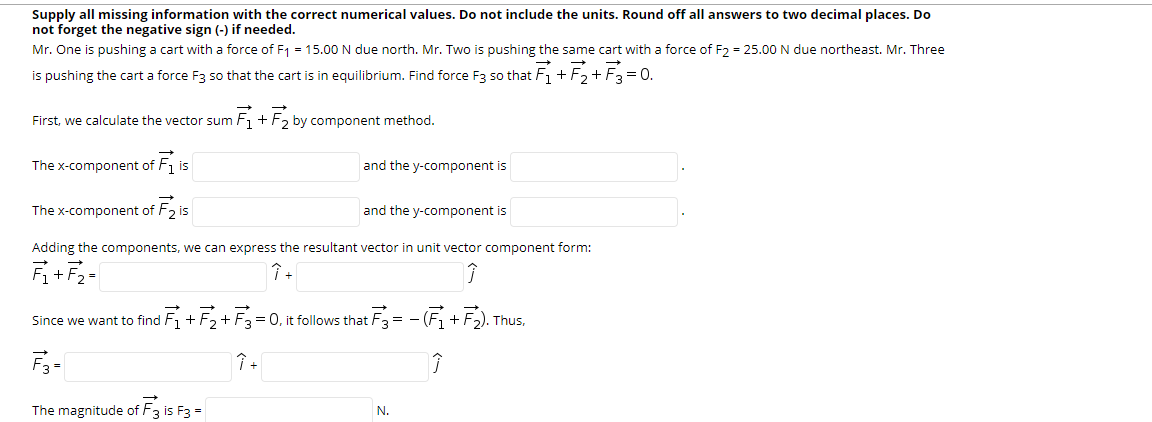Mr. One is pushing a cart with a force of F1 = 15.00 N due north. Mr. Two is pushing the same cart with a force of F2 = 25.00 N due northeast. Mr. Three is pushing the cart a force F3 so that the cart is in equilibrium. Find force F3 so that . First, we calculate the vector sum by component method. The x-component of is and the y-component is . The x-component of is and the y-component is . Adding the components, we can express the resultant vector in unit vector component form: = + Since we want to find , it follows that . Thus, = + The magnitude of is F3 = N.
Mr. One is pushing a cart with a force of F1 = 15.00 N due north. Mr. Two is pushing the same cart with a force of F2 = 25.00 N due northeast. Mr. Three is pushing the cart a force F3 so that the cart is in equilibrium. Find force F3 so that . First, we calculate the vector sum by component method. The x-component of is and the y-component is . The x-component of is and the y-component is . Adding the components, we can express the resultant vector in unit vector component form: = + Since we want to find , it follows that . Thus, = + The magnitude of is F3 = N.
Glencoe Physics: Principles and Problems, Student Edition
1st Edition
ISBN:9780078807213
Author:Paul W. Zitzewitz
Publisher:Paul W. Zitzewitz
Chapter1: A Physics Toolkit
Section: Chapter Questions
Problem 7STP
Related questions
Question
Mr. One is pushing a cart with a force of F1 = 15.00 N due north. Mr. Two is pushing the same cart with a force of F2 = 25.00 N due northeast. Mr. Three is pushing the cart a force F3 so that the cart is in equilibrium. Find force F3 so that .
First, we calculate the vector sum by component method.
The x-component of is and the y-component is .
The x-component of is and the y-component is .
Adding the components, we can express the resultant vector in unit vector component form:
= +
Since we want to find , it follows that . Thus,
= +
The magnitude of is F3 = N.

Transcribed Image Text:Supply all missing information with the correct numerical values. Do not include the units. Round off all answers to two decimal places. Do
not forget the negative sign (-) if needed.
Mr. One is pushing a cart with a force of F1 = 15.00 N due north. Mr. Two is pushing the same cart with a force of F2 = 25.00 N due northeast. Mr. Three
is pushing the cart a force F3 so that the cart is in equilibrium. Find force F3 so that Fi + F, + F3= 0.
First, we calculate the vector sum
+ F2 by component method.
The x-component of F, is
and the y-component is
The x-component of F, is
and the y-component is
Adding the components, we can express the resultant vector in unit vector component form:
F +F2=
Since we want to find F, + F2+
3 =0, it follows that F3 = - (F, + F).
Thus,
F3-
The magnitude of F3 is F3 =
N.
Expert Solution
This question has been solved!
Explore an expertly crafted, step-by-step solution for a thorough understanding of key concepts.
This is a popular solution!
Trending now
This is a popular solution!
Step by step
Solved in 4 steps with 1 images

Knowledge Booster
Learn more about
Need a deep-dive on the concept behind this application? Look no further. Learn more about this topic, physics and related others by exploring similar questions and additional content below.Recommended textbooks for you

Glencoe Physics: Principles and Problems, Student…
Physics
ISBN:
9780078807213
Author:
Paul W. Zitzewitz
Publisher:
Glencoe/McGraw-Hill

Physics for Scientists and Engineers: Foundations…
Physics
ISBN:
9781133939146
Author:
Katz, Debora M.
Publisher:
Cengage Learning

Glencoe Physics: Principles and Problems, Student…
Physics
ISBN:
9780078807213
Author:
Paul W. Zitzewitz
Publisher:
Glencoe/McGraw-Hill

Physics for Scientists and Engineers: Foundations…
Physics
ISBN:
9781133939146
Author:
Katz, Debora M.
Publisher:
Cengage Learning